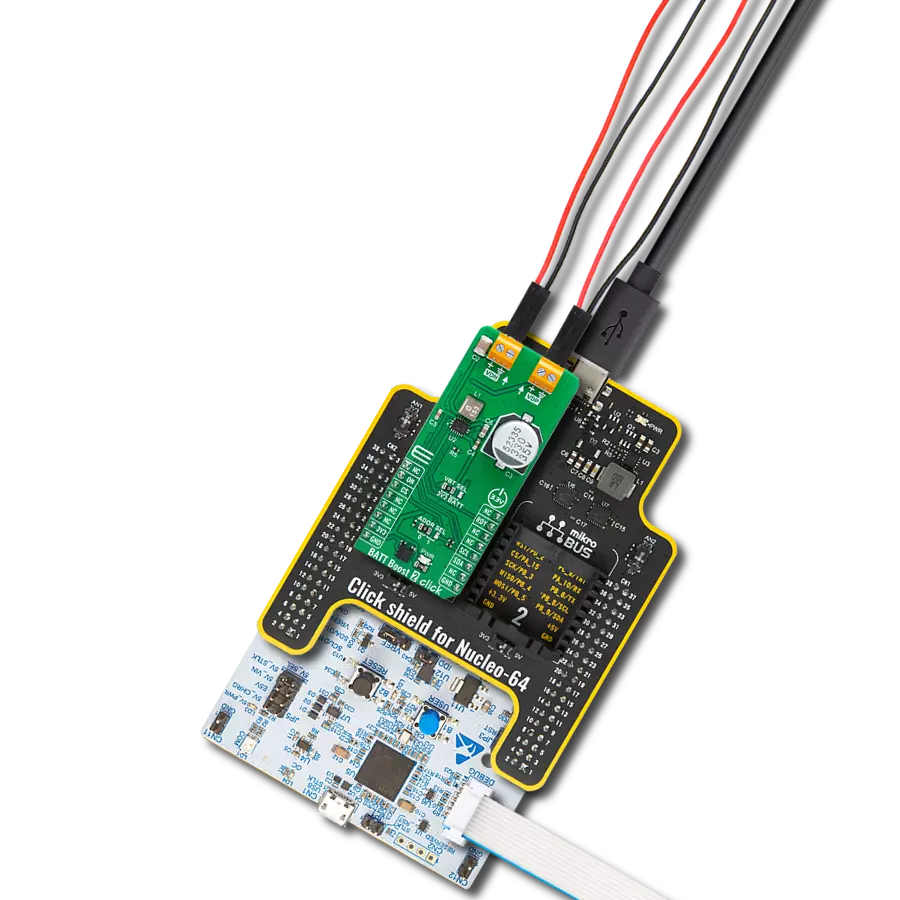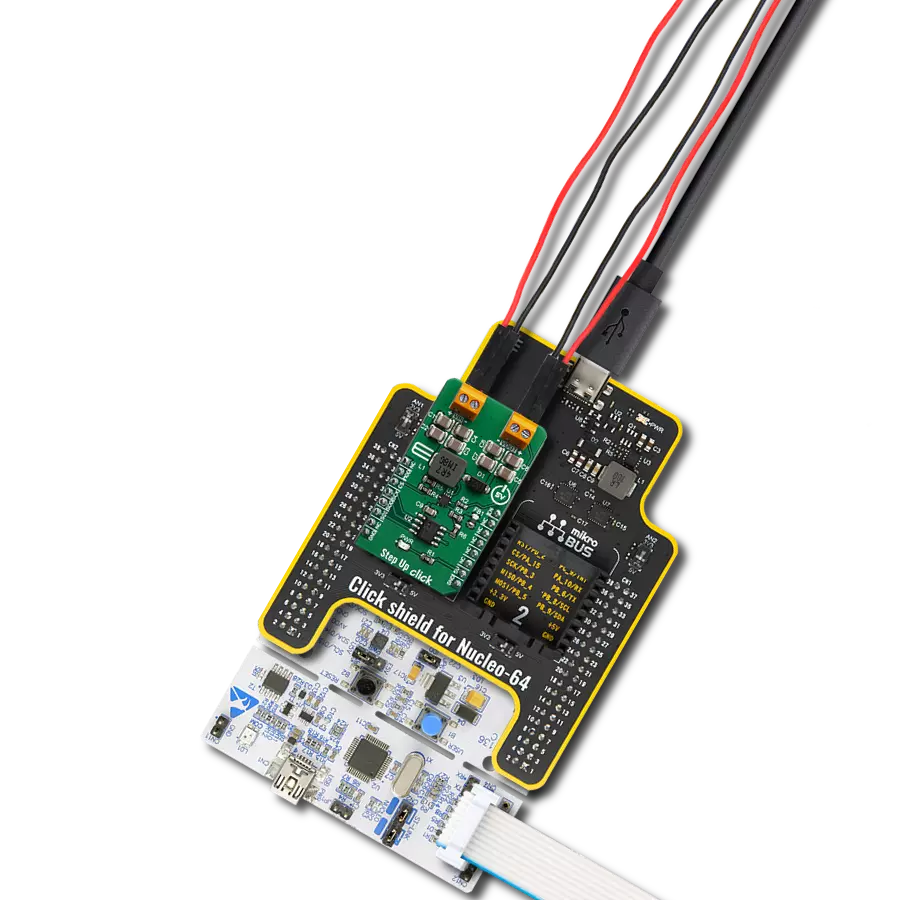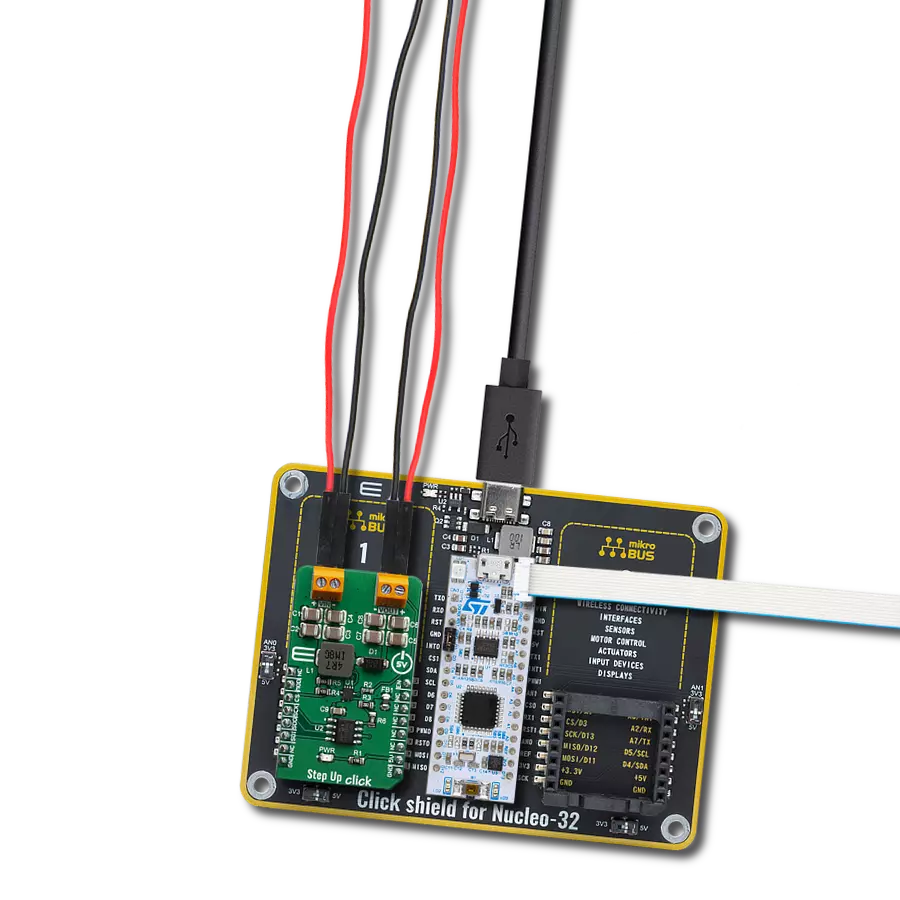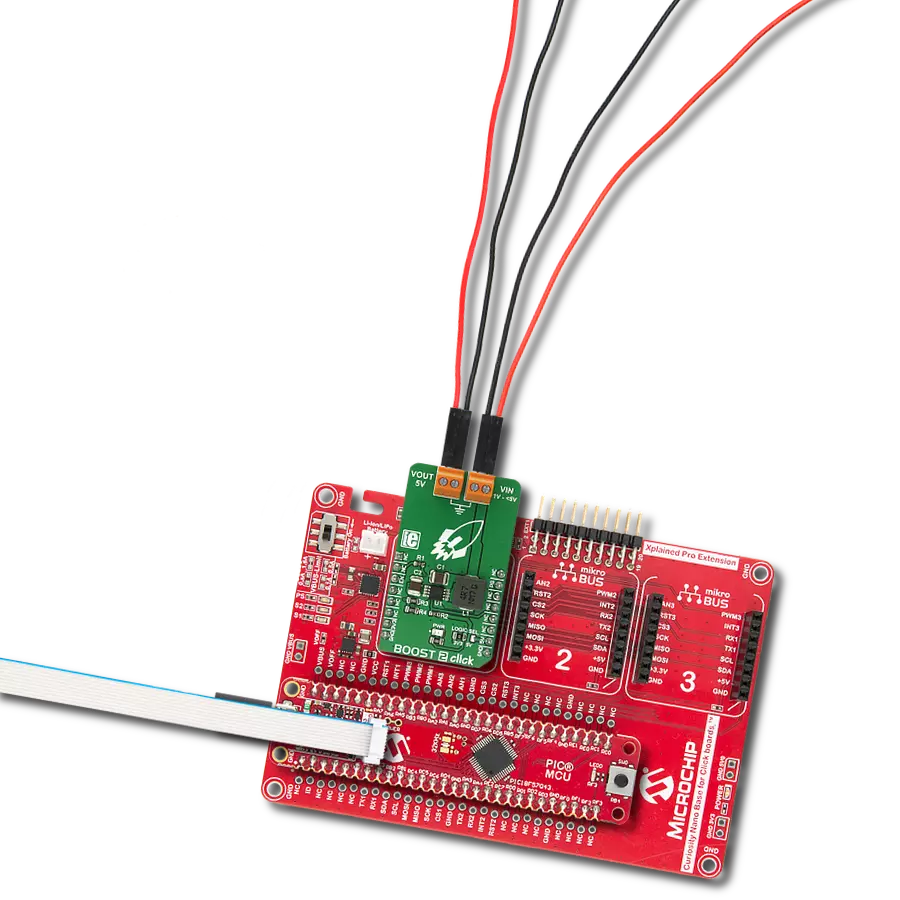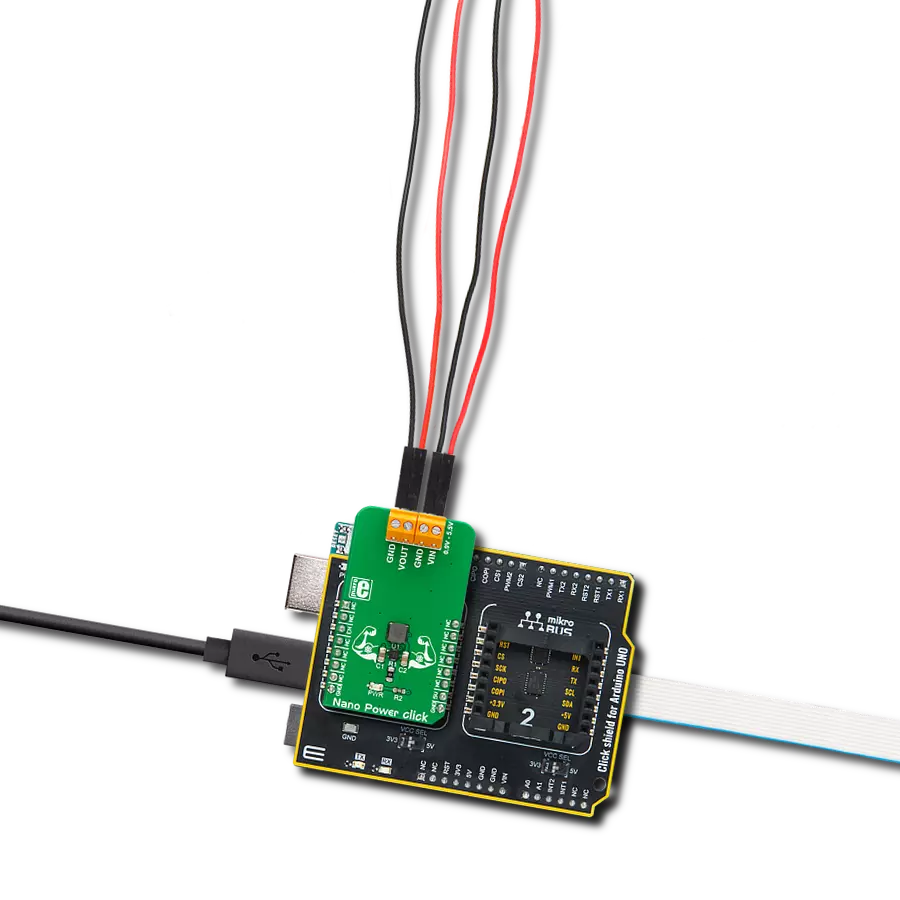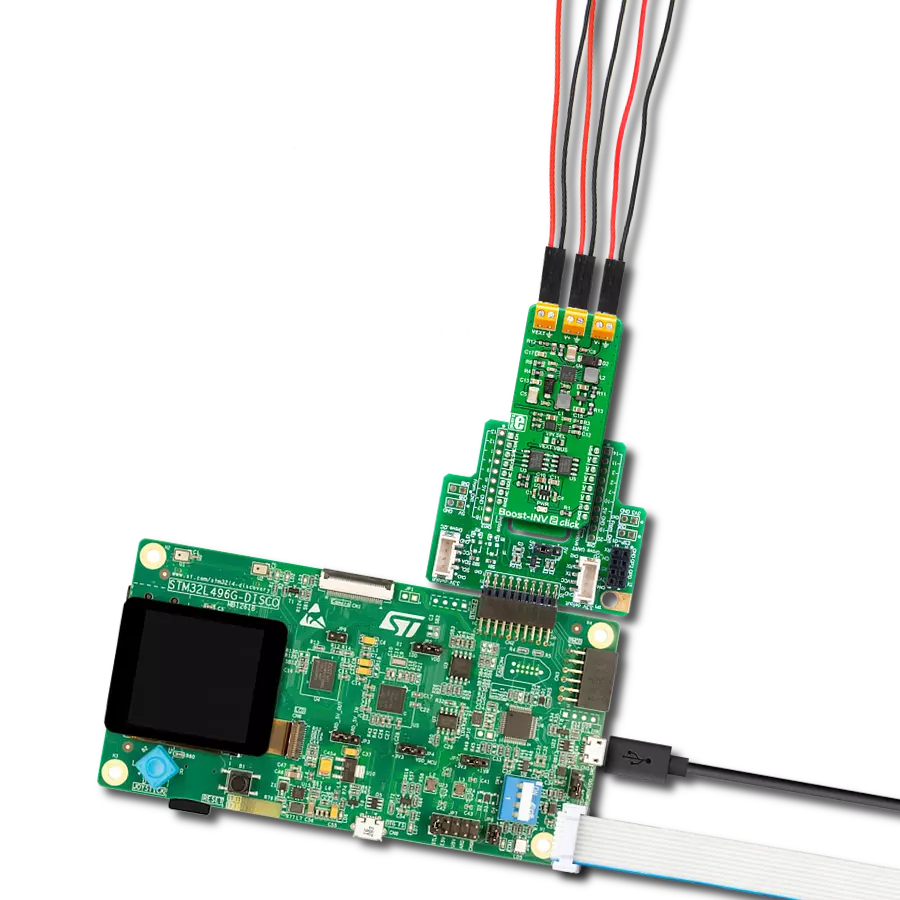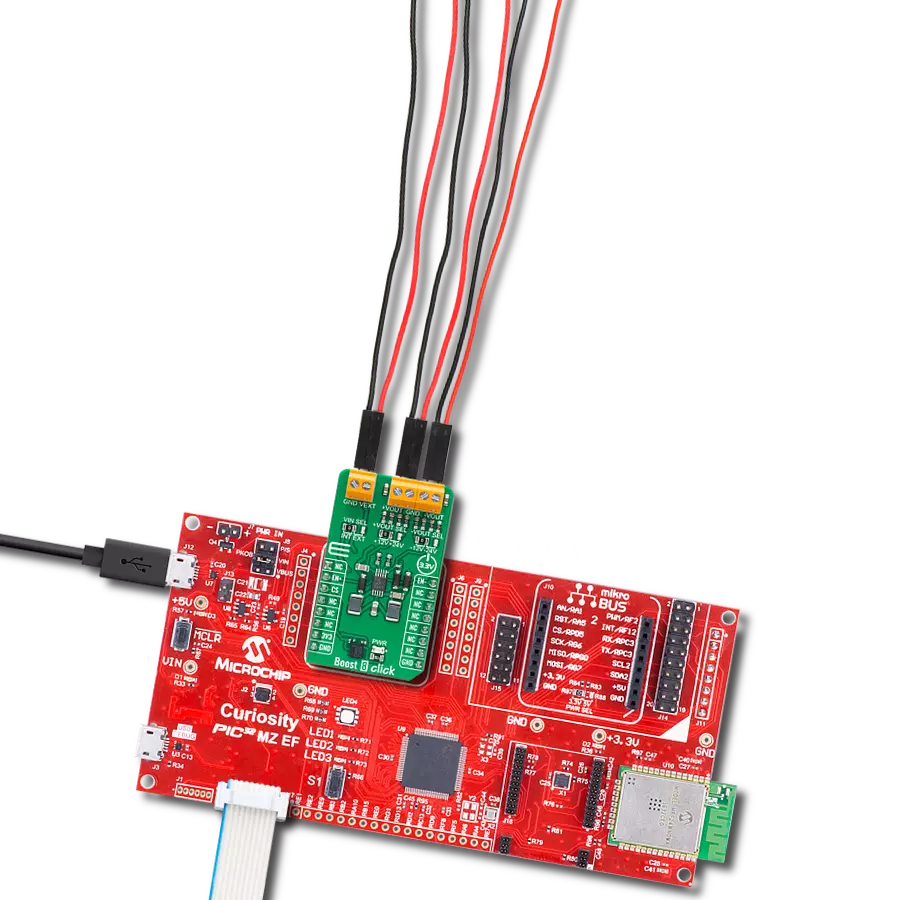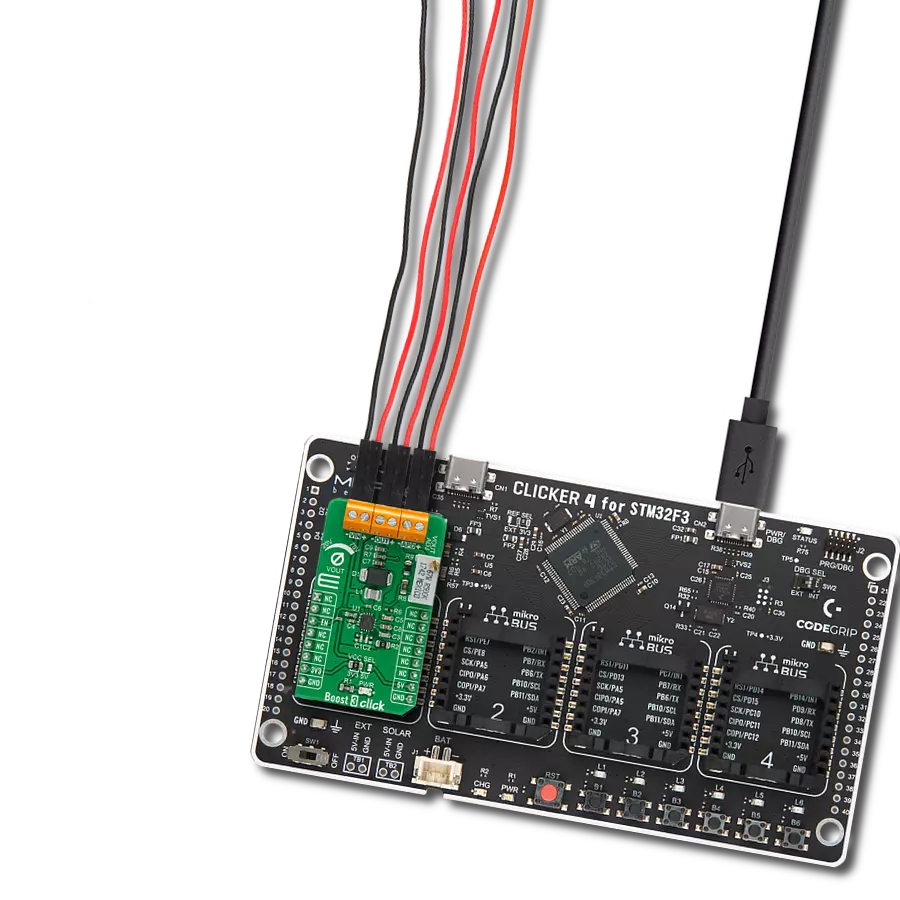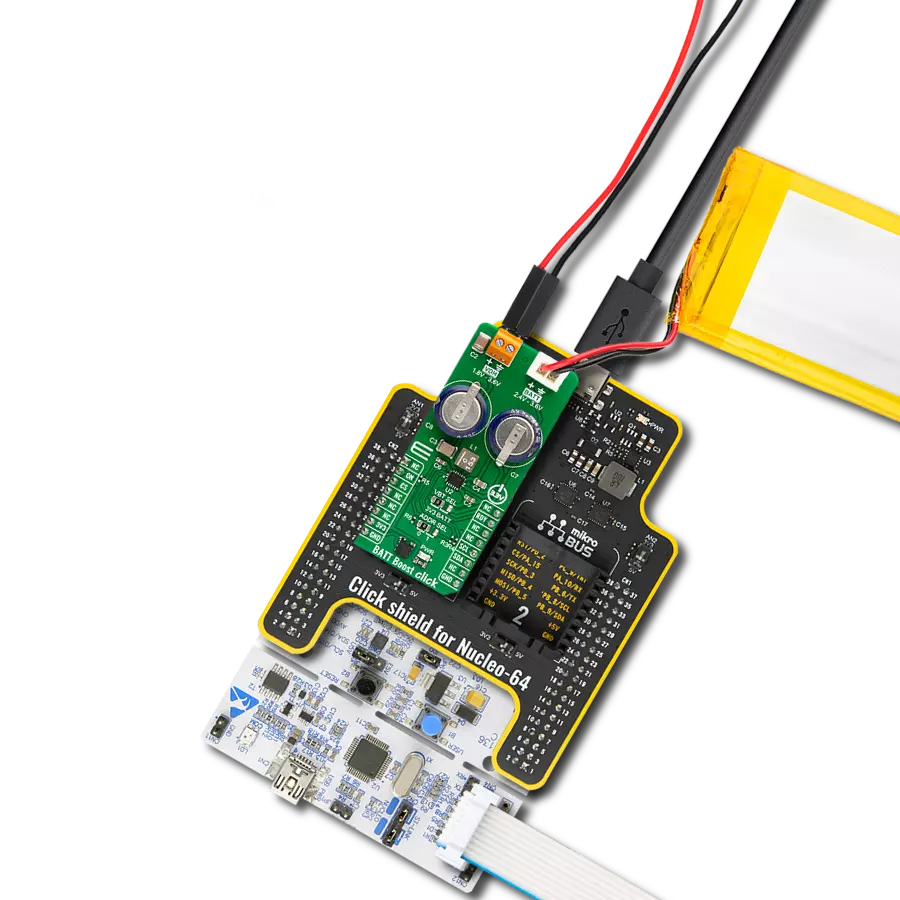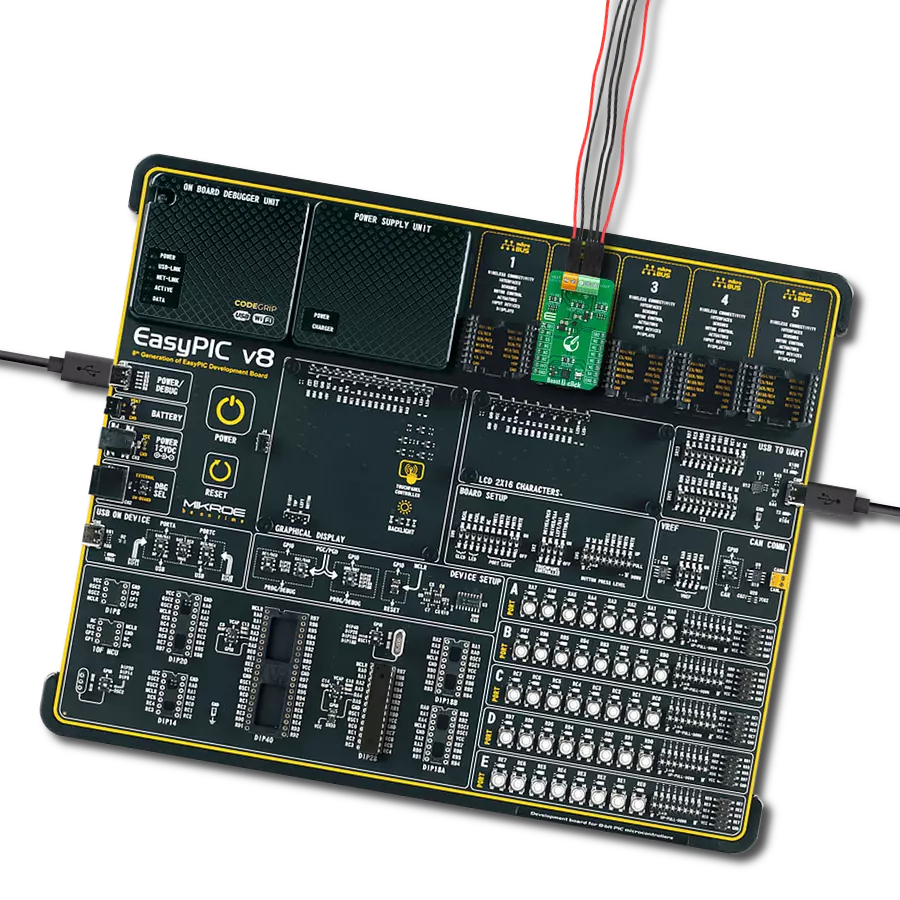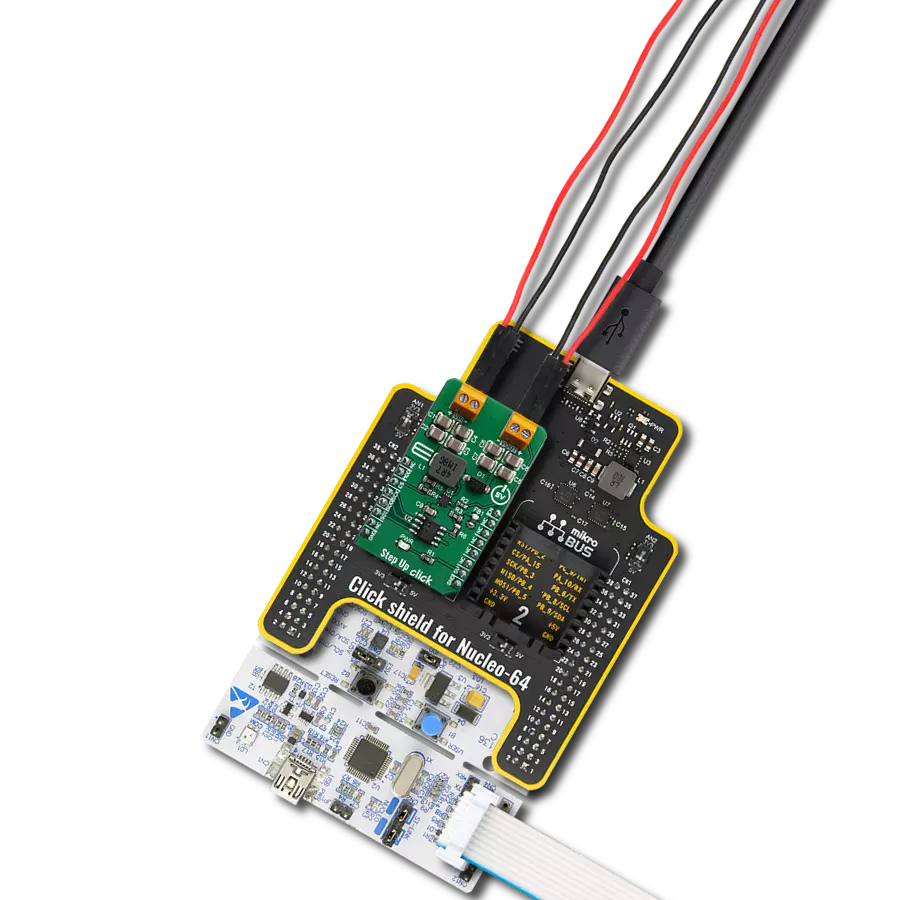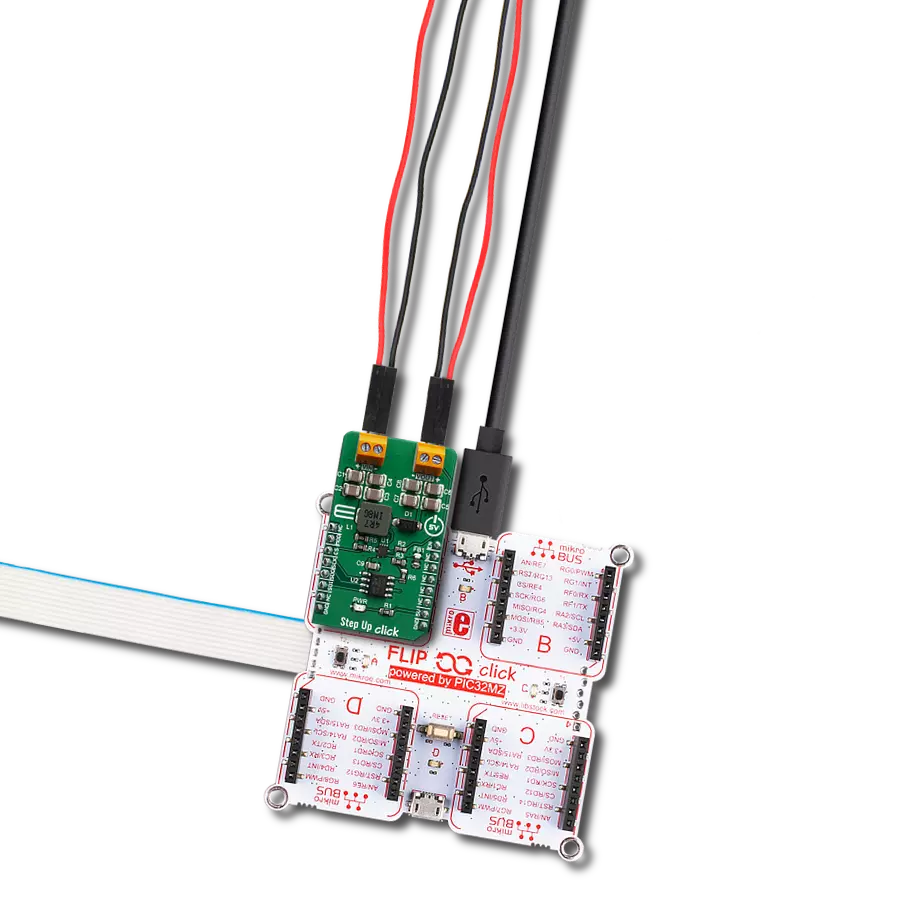Increase voltage from a lower battery level to a standard USB-Type C 5V for powering various portable electronics
A
A
Hardware Overview
How does it work?
Battery Source Click is based on the TPS81256, a high-efficiency step-up converter in a MicroSiP™ package from Texas Instruments. The TPS81256 features a high-frequency synchronous step-up DC/DC converter optimized for battery-powered portable applications. It boosts power from a connected battery (input range from 2.5V to 5.5V) and delivers it via a USB Type-C connector as 5V/1A. The TPS81256 includes a switching regulator, inductor, and input/output capacitors operating at a regulated 4MHz switching frequency. It enters Power-Save mode at light load currents, maintaining high efficiency across the entire load range. The PFM mode reduces the supply current
to 43μA (typical) during light load operation, extending battery life. Additionally, it supports more than 3W output power over a full Li-Ion battery voltage range and has an input current of less than 1µA (typical) in shutdown mode, maximizing battery life. It is ideal for low-power applications that require efficient power management. This board also features an output enable function implemented via the MAX40200, allowing users to control the power delivery on the USB-C output connector digitally. This control is achieved through the EN pin of the mikroBUS™ socket, enabling precise power flow management. Additionally, the board includes a red LED indicator labeled
ENABLE, which provides a clear visual indication of active output. This allows for easy and convenient monitoring of the board's status and ensures that users can quickly verify when the output is active. This Click board™ can operate with either 3.3V or 5V logic voltage levels selected via the VCC SEL jumper. This way, both 3.3V and 5V capable MCUs can use the communication lines properly. Also, this Click board™ comes equipped with a library containing easy-to-use functions and an example code that can be used as a reference for further development.
Features overview
Development board
Fusion for TIVA v8 is a development board specially designed for the needs of rapid development of embedded applications. It supports a wide range of microcontrollers, such as different 32-bit ARM® Cortex®-M based MCUs from Texas Instruments, regardless of their number of pins, and a broad set of unique functions, such as the first-ever embedded debugger/programmer over a WiFi network. The development board is well organized and designed so that the end-user has all the necessary elements, such as switches, buttons, indicators, connectors, and others, in one place. Thanks to innovative manufacturing technology, Fusion for TIVA v8 provides a fluid and immersive working experience, allowing access
anywhere and under any circumstances at any time. Each part of the Fusion for TIVA v8 development board contains the components necessary for the most efficient operation of the same board. An advanced integrated CODEGRIP programmer/debugger module offers many valuable programming/debugging options, including support for JTAG, SWD, and SWO Trace (Single Wire Output)), and seamless integration with the Mikroe software environment. Besides, it also includes a clean and regulated power supply module for the development board. It can use a wide range of external power sources, including a battery, an external 12V power supply, and a power source via the USB Type-C (USB-C) connector.
Communication options such as USB-UART, USB HOST/DEVICE, CAN (on the MCU card, if supported), and Ethernet is also included. In addition, it also has the well-established mikroBUS™ standard, a standardized socket for the MCU card (SiBRAIN standard), and two display options for the TFT board line of products and character-based LCD. Fusion for TIVA v8 is an integral part of the Mikroe ecosystem for rapid development. Natively supported by Mikroe software tools, it covers many aspects of prototyping and development thanks to a considerable number of different Click boards™ (over a thousand boards), the number of which is growing every day.
Microcontroller Overview
MCU Card / MCU
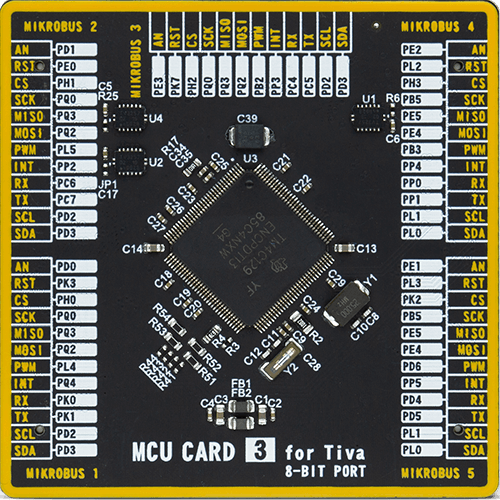
Type
8th Generation
Architecture
ARM Cortex-M4
MCU Memory (KB)
1024
Silicon Vendor
Texas Instruments
Pin count
128
RAM (Bytes)
262144
You complete me!
Accessories
Li-Polymer Battery is the ideal solution for devices that demand a dependable and long-lasting power supply while emphasizing mobility. Its compatibility with mikromedia boards ensures easy integration without additional modifications. With a voltage output of 3.7V, the battery meets the standard requirements of many electronic devices. Additionally, boasting a capacity of 2000mAh, it can store a substantial amount of energy, providing sustained power for extended periods. This feature minimizes the need for frequent recharging or replacement. Overall, the Li-Polymer Battery is a reliable and autonomous power source, ideally suited for devices requiring a stable and enduring energy solution. You can find a more extensive choice of Li-Polymer batteries in our offer.
Used MCU Pins
mikroBUS™ mapper
Take a closer look
Click board™ Schematic
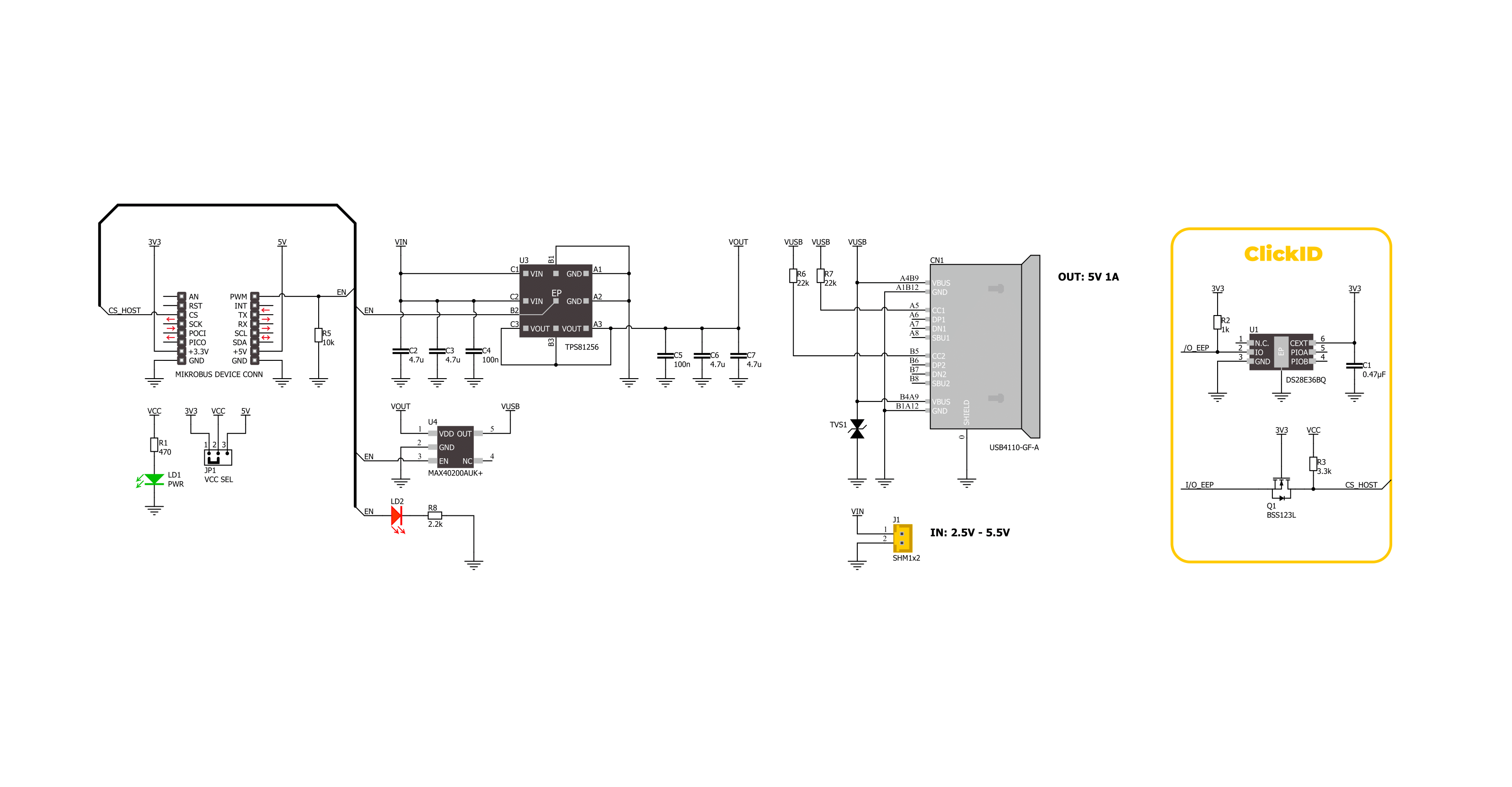
Step by step
Project assembly
Software Support
Library Description
This library contains API for Battery Source Click driver.
Key functions:
batterysource_set_output- This function is used to set output state of Battery Source Click.
Open Source
Code example
The complete application code and a ready-to-use project are available through the NECTO Studio Package Manager for direct installation in the NECTO Studio. The application code can also be found on the MIKROE GitHub account.
/*!
* @file main.c
* @brief Battery Source Click Example.
*
* # Description
* This example demonstrates the use of Battery Source Click board,
* by changing state of the output.
*
* The demo application is composed of two sections :
*
* ## Application Init
* Initializes the driver and disables the output.
*
* ## Application Task
* Enabling output for 5 seconds, then disabling it for 5 seconds.
*
* @author Stefan Ilic
*
*/
#include "board.h"
#include "log.h"
#include "batterysource.h"
static batterysource_t batterysource; /**< Battery Source Click driver object. */
static log_t logger; /**< Logger object. */
void application_init ( void )
{
log_cfg_t log_cfg; /**< Logger config object. */
batterysource_cfg_t batterysource_cfg; /**< Click config object. */
/**
* Logger initialization.
* Default baud rate: 115200
* Default log level: LOG_LEVEL_DEBUG
* @note If USB_UART_RX and USB_UART_TX
* are defined as HAL_PIN_NC, you will
* need to define them manually for log to work.
* See @b LOG_MAP_USB_UART macro definition for detailed explanation.
*/
LOG_MAP_USB_UART( log_cfg );
log_init( &logger, &log_cfg );
log_info( &logger, " Application Init " );
// Click initialization.
batterysource_cfg_setup( &batterysource_cfg );
BATTERYSOURCE_MAP_MIKROBUS( batterysource_cfg, MIKROBUS_1 );
if ( DIGITAL_OUT_UNSUPPORTED_PIN == batterysource_init( &batterysource, &batterysource_cfg ) )
{
log_error( &logger, " Communication init." );
for ( ; ; );
}
batterysource_set_output( &batterysource, BATTERYSOURCE_DISABLE_OUTPUT );
log_info( &logger, " Application Task " );
}
void application_task ( void )
{
log_printf( &logger, " Output is enabled \r\n" );
batterysource_set_output( &batterysource, BATTERYSOURCE_ENABLE_OUTPUT );
Delay_ms ( 1000 );
Delay_ms ( 1000 );
Delay_ms ( 1000 );
Delay_ms ( 1000 );
Delay_ms ( 1000 );
log_printf( &logger, " Output is disabled \r\n" );
batterysource_set_output( &batterysource, BATTERYSOURCE_DISABLE_OUTPUT );
Delay_ms ( 1000 );
Delay_ms ( 1000 );
Delay_ms ( 1000 );
Delay_ms ( 1000 );
Delay_ms ( 1000 );
}
int main ( void )
{
/* Do not remove this line or clock might not be set correctly. */
#ifdef PREINIT_SUPPORTED
preinit();
#endif
application_init( );
for ( ; ; )
{
application_task( );
}
return 0;
}
// ------------------------------------------------------------------------ END
Additional Support
Resources
Category:Boost



















